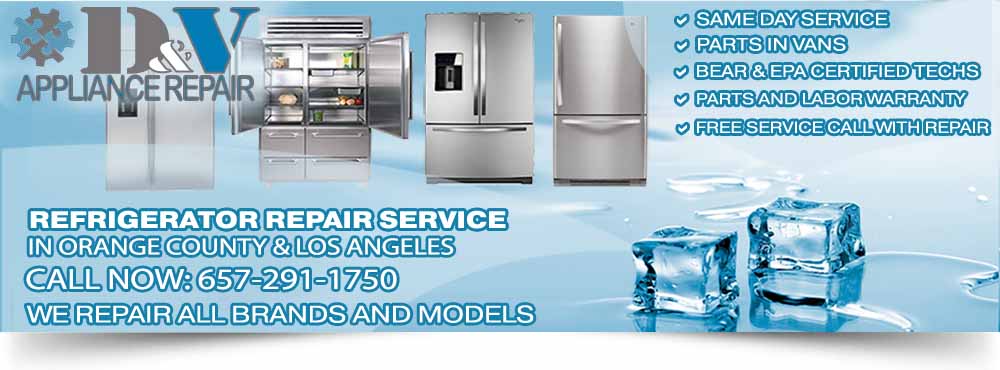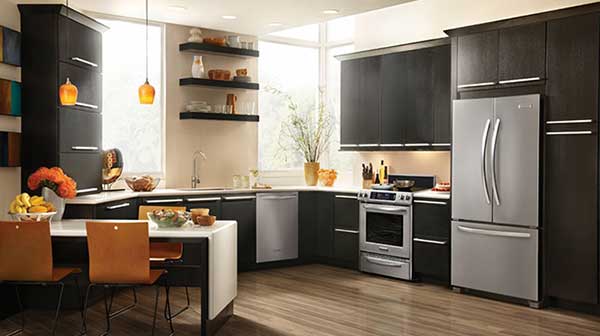KitchenAid refrigerators are state-of-the-art food preservation systems, renowned for their reliability and efficiency. Whether you’re storing fresh produce or chilling beverages, these refrigerators offer unparalleled performance. It is always best to invest in a good refrigeration system, such as KitchenAid, as the refrigerator is the home appliance that works the hardest day in and day out. Imagine how much it works without you even lifting a finger, and it barely even breaks down. In case of any issues, prompt KitchenAid Refrigerator Repair ensures your appliance continues to function flawlessly.
After the iconic Stand Mixer was born in 1919, KitchenAid has introduced an entire kitchen of quality products and appliances that is backed up by their attention to detail, quality, and craftsmanship. As being in the business for so long, KitchenAid now offers a wide-range of refrigerators available for use. They have freestanding refrigerators, built-in refrigerators, wine cellar refrigerators, ice makers, bottom freezers, and even specialty refrigerators that all guarantee to keep food and beverage fresh and safe.
But despite having quality in mind, there will be times when a refrigerator just won’t work. In the event that a refrigerator breaks down though, here are a few KitchenAid refrigerator repair ideas on how to try and fix the refrigerator yourself.
Clean your condenser coils at least twice a year.
Condenser coils are in charge of transferring heat from refrigerators and freezers. First, make sure that the refrigerator is disconnected from the electric outlet and that the power is off. Next, locate the condenser coils. There are usually two sets of coils for cooling appliances – the evaporator and condenser coils. For old refrigerators, the condenser coil may be located on the rear of the refrigerator. On most refrigerators however, the condenser coil may be found at the bottom. Carefully vacuum the visible dust and dirt from the coil and fan but make sure not to damage the parts.
Defrost your refrigerator and freezer.
Minimize the need for refrigerator repair by defrosting your refrigerator and freezer every once in a while. This will also help make your refrigerator and freezer working efficiently. Defrosting is a pretty easy job as it only requires an ample amount of time to do. First, remove the contents of your refrigerator and freezer. Turn the power off and keep the doors of the fridge and freezer open. This would also be a great time to clean the shelves of your fridge – give them a good wash and scrubbing. Allow all the frost to melt. If you want a faster procedure, get a hair dryer and use it to soften blocks of ice to easily chip it off and avoid having pools of water running everywhere. Chip off the blocks of ice using a plastic spatula, then wipe dry with a clean cloth.
Replace the rubber door seal or gasket when needed.
There may be times when you would find your refrigerator’s compressor running constantly, wasting energy and lowering down the life expectancy of your appliance. More often than not, hard or cracked refrigerator gaskets would cause this. To replace gaskets, make sure you purchase a gasket specifically made for the refrigerator you own. Before attaching the new gasket, soak it first in warm water to make it workable. Remove the old gasket on one side of the door at a time – it is usually attached using screws, clips, or adhesives. Clean the area with some water and detergent before attaching the new gasket. Slowly work the replacement starting at one side of the door, working down the sides. Smooth the gasket into place by making sure it lies flat and there are no lumps or curled edges.
Repair door hinges.
Another possible problem that you could save on refrigerator repair costs would be repairing door hinges yourself. Sometimes, gaskets may not be the source of your problems, but the door hinges itself. With opening and closing the door every so often everyday, there’s no doubt that it will one day breakdown. The easiest way to repair a door hinge is to first loosen the hinge bolts slightly with a wrench. Next, align the door so that it’s straight, and then retighten the bolts.
Fix a damaged baffle or air inlet damper.
If you feel like your refrigerator is too warm, then this could be caused by a damaged baffle or air inlet damper. The air inlet damper, baffle, or diffuser is the part of the refrigerator that balances the air flow from the evaporator fan housing. It is in charge of controlling the amount of cold air entering the food compartment. First, locate where the baffle is. Normally, it would be housed in something made of plastic and will have a Styrofoam lining to prevent air leakage. Once located, operate the control knob to verify that it moves freely. If it does, then that means it works just fine. If it’s stuck, then it should be replaced.
Locate where vibrating noises are coming from.
When your refrigerator starts to make unnecessary noises, these noised could be caused by loose parts such as loose condenser coils, compressor tubing rattling, or rollers and feet that sit unevenly on the floor. This can easily be managed by looking for the loose part and tightening it with a wrench or a screwdriver.
Fix a refrigerator’s light that stays on.
A refrigerator light that stays on despite having the door closed will warm the refrigerator’s interior. Ideally, the light should shut off once you close the door of the fridge. With most refrigerators, you will be able to see the light shut off once the door is about an inch from closing. However there may be times when the light wouldn’t shut off at all and you won’t be aware of it. Test the light switch button – if you push it all the way and the light goes off, then it works. If it doesn’t, then it needs some replacement.
Level your refrigerator.
At least once every three months, level your refrigerator from side to side and front to back. Unleveled fridges would usually cause doors to not close properly, strain motors, and cause condensation inside. To fix, place a level on top of the refrigerator then rotate the machine’s adjustable feet until the refrigerator is level.
Replace your water filter.
At least once every six months, replace your water filter. This is to ensure you have clean water and ice, and to prevent clogs and leaks. Locate where the filter of your fridge is, as it may vary from model to model. Pull it out, then pop in a new filter. Run a couple of gallons of water through it to remove any carbon residue.
Use the baking soda trick.
If you want to keep your fridge from getting smelly, keep an open box of baking soda in your fridge. The baking soda will absorb some odor-causing acids that can be caused by the things your store in your refrigerator.
However, in the event that these tips and tricks still wouldn’t work to save your precious KitchenAid refrigerator, worry not as we provide quality KitchenAid refrigerator repair services. With our trained and highly professional team, your KitchenAid refrigerator will surely be in good hands. You may choose to try us out by first giving us a call – 714-312-5968, we offer a free service call with any repair. Getting your KitchenAid refrigerator working again won’t have to take so long since we have complete genuine factory parts readily available for any sort of repair needed. And even if your KitchenAid refrigerator breaks down on an untimely hour, like evenings and weekends, there will be no extra charges for repairs. And once our certified and professional technicians are done with the job of restoring your KitchenAid refrigerator back to life, we shall definitely still be around to guide you as we will provide up to five years of extended warranty for the repair.
We provide repair and maintenance services for:
- KitchenAid French Door Refrigerators
- KitchenAid Bottom Freezers
- Side-By-Side KitchenAid Refrigerators
- KitchenAid Refrigerator Drawers
- KitchenAid Ice Makers
- KitchenAid Under Counter Refrigerators
- KitchenAid Beverage & Wine Coolers
Our advantages:
• Quality Repair. Our technicians are professionals; they are experienced and well-trained to work with high-end appliances such as KitchenAid. Of course, they are also properly licensed, certified and fully insured.
• Fast and Convenient Service. We guarantee that we can come for repair the same day you call. We will give you small 3 hours appointment window, call you when we are on our way and never be late for appointment.
• Free Estimate. Our diagnostic and estimate is free if you choose to do a repair with us. Before starting any repair job you will be given a written estimate for approval.
• 5 Year Extended Part Warranty. We extend manufacturer’s warranty for 5 Years on any replacement part.
• Stocked Vans. We load our vans as much as possible with the most common KitchenAid parts to be able to finish the repair right away in one trip.
• Flat-Rate Pricing. The price for repair has simple breakdown: Labor + Part + Tax. It’s a flat fee, we never charge hourly for labor, we don’t add any extra charges for emergency, late hours or weekends jobs.
Call us now and get your KitchenAid Refrigerator Repaired today –(657) 291-1750

